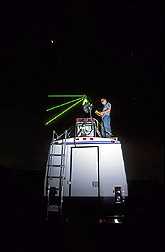|

Michael Cloos, a
University of Iowa student, adjusts the LiDAR laser. Click the image for
more information about it.
Read the
magazine
story to find out more. |
LiDAR: A Bright New Trend in Environmental
Studies By Luis
Pons
October 18, 2004
The atmosphere--and especially the air around agricultural
operations--is being studied in a whole new light with technology adapted by
Agricultural Research Service scientists
and their cooperators.
Researchers at the ARS
National
Soil Tilth Laboratory in Ames, Iowa, in collaboration with the
University of Iowa, are examining many of
the environmental and agricultural applications of the technology called LiDAR.
According to ARS laboratory director
Jerry
Hatfield, the technology may revolutionize how the air around agricultural
operations is monitored because it can pinpoint the location, distribution and
nature of airborne particles.
A product of 1960s laser studies, LiDAR--for Light Detection and
Ranging--is a radarlike technology that uses short pulses of laser light to
detect and differentiate airborne particles, gases or molecules. Its tight,
unbroken beam disperses very little as it moves away from its source.
LiDAR has been used to look at clouds and pollution plumes, hunt
submarines, nab speeders and prepare topographic elements for land and
ocean-floor maps. Hatfield and ARS soil scientist
John
Prueger--and, at times, UI professor Bill Eichinger--have used LiDAR to
monitor the accuracy of remote sensors, water uptake by trees near rivers, and
dust particles from mills, cotton gins and even odorous livestock
facilities.
The team first used LiDAR in 1998, when asked by the
U.S. Department of the Interior to study the
effect of saltcedar, an invasive and prolific shrub that extracts large amounts
of soil water while leaving behind soil-damaging salts, on western U.S.
riverbanks.
More recently, they've used it in a series of soil moisture
experiments, called SMEX, in which ARS, the
National Aeronautics and Space
Administration, the National Oceanic and
Atmospheric Administration and numerous universities are evaluating how
accurately remote sensors on satellites, aircraft and land-based towers monitor
ground-level moisture.
Hatfield, through an agreement with UI, is currently studying
LiDAR's performance in evaluating dispersion dynamics around swine-production
facilities.
Read more
about this research in the October 2004 issue of Agricultural Research
magazine.
ARS is the U.S. Department of
Agriculture's chief scientific research agency. |